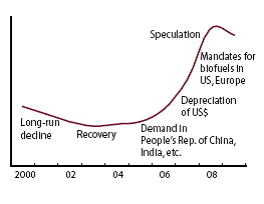One of the first chapters that an economics student will have to learn is probably the theory of demand and supply. Considering all the theories of economics that have evolved over the years, this theory of demand and supply must is one of the most fundamental. Like all other commodities and services, food prices are also affected by this theory. The basic premise of the demand side of the theory is that when prices fall, demand will increase and vice-versa. With regard to supply, the opposite holds good. When prices increase manufacturers and growers will try to increase the supply. On a graph, the demand curve will be a downward one whereas the supply curve will be an upward one.

Time is a factor that plays a major part in the case of supply. The manufactures should have sufficient time to meet the increase in supply. In the case of food, this is more crucial since a crop will take its own time for maturing unlike in manufacture. When supply matches demand (un unlikely situation) it is known as equilibrium. Disequilibrium occurs when either supply exceed demand or vice versa. In high price situation, demand will be low and hence there will be excess supply. When price is low, there will be high demand but supplier will not be willing to meet it (for fear of losses).
Production and supply of agricultural products is subject to a lot of factors. The world food prices have been growing steadily since 2006 onwards even though it fell slightly in 2008. This can be seen from the graph given below. The increase in 2007 was dramatic when compared to the year 2005.

Specific demand factors affecting food prices:
There are several factors that have seen in the increase in demand of food.
Technology for the creation of bio-fuels is developing fast in many countries. In an effort to conserve oil reserves and also to reduce environmental damage, the demands for food items that can be used to make bio-fuels have increased sharply. The main demand is for corn (for making ethanol) and vegetable oils (for making bio-diesel). Massive quantities will be needed to make the production economical. Another example is maize. “For example, out of nearly 40 million tonnes increase in total world maize utilization in 2007, almost 30 million tonnes were absorbed by ethanol plants alone.”
This has resulted in a totally new area of demand unrelated to human consumption. The rising economies of many Asian, Latin American and East European countries (India and China stand out) has resulted in a demand for better diet and nutrition. This has simply translated into higher demand for food in general. International food prices are quoted in dollars and its depreciation has also resulted in an increase in prices. Food has now become a common part of the commodity market (like oil, gold and silver). High speculation has resulted in volatility of prices rising and falling irrespective of demand and supply. Finally the rise in petroleum prices has indirectly increased food prices also due to increased transportation, irrigation and other processing costs.
Specific supply factors affecting food prices:
Below average production in many areas of Europe and in Australia was one reason affecting supply. Reduced agricultural subsidies (especially in OECD countries) have resulted in reduced profitability. Lower interest in agriculture has resulted in a fall in supply. Climate change is another factor affecting supply. For example, unexpected draught in Australia has resulted in much lower agricultural output for the last two years.

